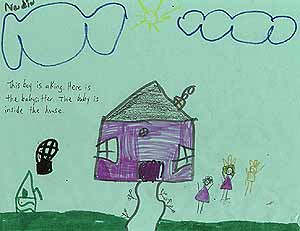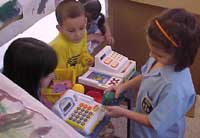Language Skills.
EIS's entire curriculum is based on English language proficiency.
It is absolutely critical that our kids get a solid base in this language.
Fluency in a language is not acquired by filling out a worksheet or watching
a video. Language is learned by HEARING it and USING it in
natural, every-day context. Fours must be immersed in English if
they are to 'get it'. Learning language is one of the easiest skills
in the world. Unfortunately, adults make it one of the most difficult by
assuming they have to grind through the alphabet, phonics, worksheets and
oral lessons. Reading to children every day and speaking to them
about their areas of interest are the best ways to acquire language naturally.
This is the primary goal of EIS four program. For this reason, we
use only English in the classroom after a one month adjustment period.
 Emerging
literacy. Four year olds are beginning to realize what it
means to read and write. They are very excited about this means of
communication. A four-year-old classroom needs to be print-rich and full
of language: books, music, labels, writing media and toys that encourage
communication. Children need to be given the opportunity to develop
their hand muscles so they can control writing instruments. They need to
have lots of time with books to figure out 'how' we read (left to right,
up to down, front to back etc). They need to see lots of text around
the room so they associate the spoken word with the written word.
They need to be read at least 5 books a day. They need time to ask
questions, get answers, draw conclusions, discuss the storyline, and integrate
the message into their lives.
Emerging
literacy. Four year olds are beginning to realize what it
means to read and write. They are very excited about this means of
communication. A four-year-old classroom needs to be print-rich and full
of language: books, music, labels, writing media and toys that encourage
communication. Children need to be given the opportunity to develop
their hand muscles so they can control writing instruments. They need to
have lots of time with books to figure out 'how' we read (left to right,
up to down, front to back etc). They need to see lots of text around
the room so they associate the spoken word with the written word.
They need to be read at least 5 books a day. They need time to ask
questions, get answers, draw conclusions, discuss the storyline, and integrate
the message into their lives.
Social skills/self help skills.
Practice makes perfect! Skills like constructive conflict resolution,
self-help and self-control require practice. We create a positive
environment where this can happen. Likewise, four year olds are beginning
to experiment with ethics and morality: what is good? What is bad?
Why? Do the rules about good and bad change for different circumstances?
Fours work through these questions by playing. Their toys are their
world. They construct and manipulate this world to help them figure
out society's expectations for behavior. Early childhood programs
provide time and opportunity for this - as well as strong examples with
caring, empathetic and patient teachers.
 School
Concepts. Four year olds are ready to start a basic academic program.
As with any developmentally appropriate early childhood program, our four-year-old
program offers a variety of learning opportunities by employing learning
centers and theme-based instruction. We incorporate math/science,
reading/writing, dramatic play, blocks, and art centers into our day to
provide students with a variety of challenging activities. Our centers
support our core themes, which are child-centered and age-appropriate.
The basics are: the self, the family, bugs, gardening, environment, community
helpers, dinosaurs, nursery rhymes, and animals. Through these themes,
we introduce lessons in size classification, patterns and sequencing, letter
recognition, number association, English phrases and vocabulary and emergent
writing skills.
School
Concepts. Four year olds are ready to start a basic academic program.
As with any developmentally appropriate early childhood program, our four-year-old
program offers a variety of learning opportunities by employing learning
centers and theme-based instruction. We incorporate math/science,
reading/writing, dramatic play, blocks, and art centers into our day to
provide students with a variety of challenging activities. Our centers
support our core themes, which are child-centered and age-appropriate.
The basics are: the self, the family, bugs, gardening, environment, community
helpers, dinosaurs, nursery rhymes, and animals. Through these themes,
we introduce lessons in size classification, patterns and sequencing, letter
recognition, number association, English phrases and vocabulary and emergent
writing skills.

